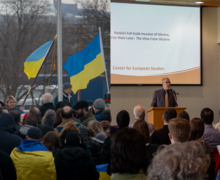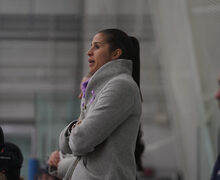SU officials explain how university became top tier research school
Courtesy of Caltech Media Assets
Three Syracuse University professors recently helped discover gravitational waves, which officials said is a sign of the university's dedication to research.
The recognition of a strong research presence on campus is the culmination of years of investment in the research sector by Syracuse University officials.
In the 2015 Carnegie Classification of Institutions of Higher Education, released on Feb. 1, the university was ranked as an R1 institution, putting it among the most elite universities with doctoral programs in the country. Days later, SU announced three of its professors were instrumental in the discovery of gravitational waves.
Liz Liddy, interim vice chancellor and provost at SU, said these developments are a sign that the university is moving forward with its goal to become a “pre-eminent student-focused research university.”
While there is debate in academia about students being sidelined for research, SU officials insisted that teaching has thrived off it. A prospering research program attracts the best faculty, they said, which in turn improves the student experience.
To them, the inclusion of research in future plans for the university will strengthen academics across campus.
The Carnegie Classification, which is reevaluated every five years, is the industry standard for research quality at educational institutions. In 2010, SU was placed in the R2 designation, which is defined as “higher research activity.”
The R1 designation puts the university in the “highest research activity” category among doctoral-conferring institutions.
Karin Ruhlandt, dean of the College of Arts and Sciences, said the ranking is a “stamp of approval” for the university.
This is an affirmation of the good research we do. You aren’t just bumped up overnight. This is work you do for years.Karin Ruhlandt
The ranking is the result of the combined efforts of past and current deans, provosts and chancellors, said Peter Vanable, interim vice president for research at SU.
Vanable, who officially started in his position on Jan. 1, said many of the recent developments happening in the research sector are results of the hard work of his predecessor, Gina Lee-Glauser.
“You don’t just wave a wand and see rankings reflect increased research productivity,” he said.

Courtesy of Caltech Media Assets
The discovery of gravitational waves is indicative of that, Vanable said, because it took many years to accomplish. He described the discovery as a testament to the value of long-term investment in research, which he said is how institutions climb in rankings.
Vanable said he could not yet provide an exact breakdown of how the university evolved to earn the R1 ranking, but public files developed by the Carnegie Classification show that SU improved across a range of categories.
The 2010 classification reported that SU spent $30,560 in science and engineering research and development expenditures — one of the variables doctoral institutions are judged on. The 2015 classification reports the university spent $48,034 in the 2014 fiscal year.
The university also increased its science and engineering research staff, which the analysis describes as postdoctoral appointees and other non-faculty research staff with doctorates. The 2010 classification reported the university had 46 of these staff members, which grew to 65 in the 2015 classification.
Liddy, Ruhlandt and Vanable all said that another one of SU’s strengths — which is not included in the classification — is engaging undergraduate students in research and still maintaining the quality of teaching.
“It is expected that all the researchers teach,” Ruhlandt said. “When we interview people for faculty positions it is made clear that instruction is expected.”
Some in academia have voiced concerns, though, that an increased focus on research ultimately devalues teaching. A study from Northwestern University found that average and below-average freshman students found it more difficult to learn from tenure-track professors in their introductory courses.
SU officials insisted, though, that a strong research faculty has improved the student experience on campus.
Ruhlandt said Duncan Brown, a physics professor at SU and one of the scientists who helped discover gravitational waves, teaches a large introductory-level astronomy class and “is an absolute rock star in the classroom.”
The university also takes the time to include undergraduates in this cutting-edge research, Ruhlandt said. Most bachelor of science degrees require some undergraduate research, which Ruhlandt said is key to the student experience.
You don’t need to worry about undergraduate research to get the R1 ranking. But we certainly do.Karin Ruhlandt
Moving forward, Liddy said the administration is looking to continue prioritizing research. To do so, it has added the continued support of research to the Academic Strategic Plan, which is part of Chancellor Kent Syverud’s Fast Forward initiative.
Liddy said that has to be a part of the plan if the university’s goal is to become a student-focused research institution.
This commitment to research will also help attract top-notch faculty, Vanable said. In turn, students will get even better teachers, he added.
“They’ll realize that the timing is good,” Vanable said. “That coming to SU now means joining a faculty where research excellence is an expectation and that your strong research efforts will be rewarded.”
Published on March 1, 2016 at 12:09 am
Contact Delaney: dovanwey@syr.edu





